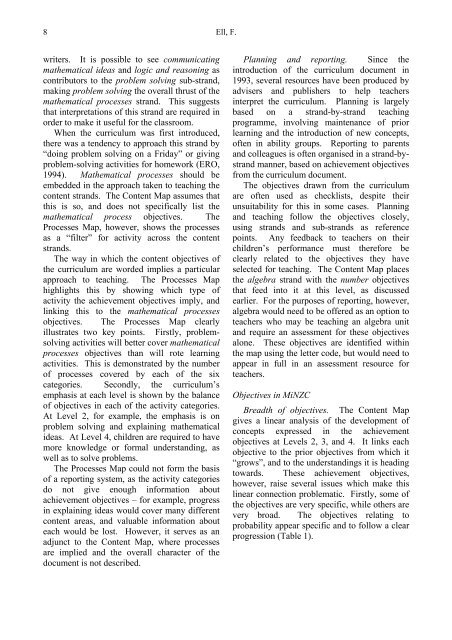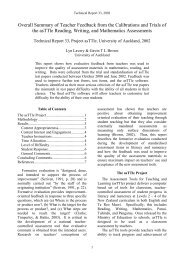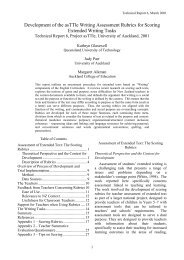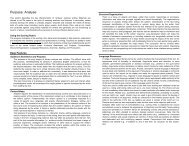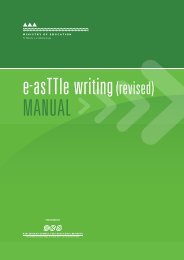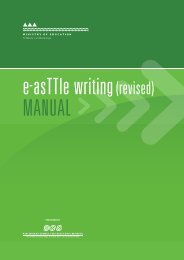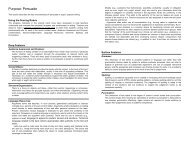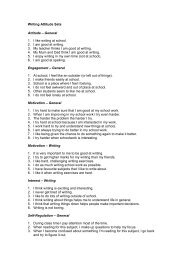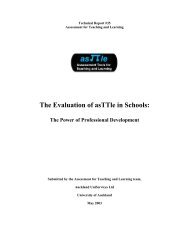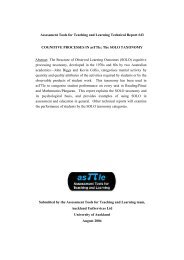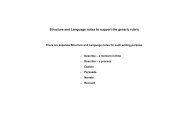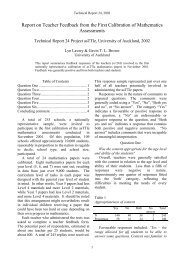11. Maths in the NZ curriculum 2001.pdf - e-asTTle - Te Kete Ipurangi
11. Maths in the NZ curriculum 2001.pdf - e-asTTle - Te Kete Ipurangi
11. Maths in the NZ curriculum 2001.pdf - e-asTTle - Te Kete Ipurangi
You also want an ePaper? Increase the reach of your titles
YUMPU automatically turns print PDFs into web optimized ePapers that Google loves.
8 Ell, F.<br />
writers. It is possible to see communicat<strong>in</strong>g<br />
ma<strong>the</strong>matical ideas and logic and reason<strong>in</strong>g as<br />
contributors to <strong>the</strong> problem solv<strong>in</strong>g sub-strand,<br />
mak<strong>in</strong>g problem solv<strong>in</strong>g <strong>the</strong> overall thrust of <strong>the</strong><br />
ma<strong>the</strong>matical processes strand. This suggests<br />
that <strong>in</strong>terpretations of this strand are required <strong>in</strong><br />
order to make it useful for <strong>the</strong> classroom.<br />
When <strong>the</strong> <strong>curriculum</strong> was first <strong>in</strong>troduced,<br />
<strong>the</strong>re was a tendency to approach this strand by<br />
“do<strong>in</strong>g problem solv<strong>in</strong>g on a Friday” or giv<strong>in</strong>g<br />
problem-solv<strong>in</strong>g activities for homework (ERO,<br />
1994). Ma<strong>the</strong>matical processes should be<br />
embedded <strong>in</strong> <strong>the</strong> approach taken to teach<strong>in</strong>g <strong>the</strong><br />
content strands. The Content Map assumes that<br />
this is so, and does not specifically list <strong>the</strong><br />
ma<strong>the</strong>matical process objectives. The<br />
Processes Map, however, shows <strong>the</strong> processes<br />
as a “filter” for activity across <strong>the</strong> content<br />
strands.<br />
The way <strong>in</strong> which <strong>the</strong> content objectives of<br />
<strong>the</strong> <strong>curriculum</strong> are worded implies a particular<br />
approach to teach<strong>in</strong>g. The Processes Map<br />
highlights this by show<strong>in</strong>g which type of<br />
activity <strong>the</strong> achievement objectives imply, and<br />
l<strong>in</strong>k<strong>in</strong>g this to <strong>the</strong> ma<strong>the</strong>matical processes<br />
objectives. The Processes Map clearly<br />
illustrates two key po<strong>in</strong>ts. Firstly, problemsolv<strong>in</strong>g<br />
activities will better cover ma<strong>the</strong>matical<br />
processes objectives than will rote learn<strong>in</strong>g<br />
activities. This is demonstrated by <strong>the</strong> number<br />
of processes covered by each of <strong>the</strong> six<br />
categories. Secondly, <strong>the</strong> <strong>curriculum</strong>’s<br />
emphasis at each level is shown by <strong>the</strong> balance<br />
of objectives <strong>in</strong> each of <strong>the</strong> activity categories.<br />
At Level 2, for example, <strong>the</strong> emphasis is on<br />
problem solv<strong>in</strong>g and expla<strong>in</strong><strong>in</strong>g ma<strong>the</strong>matical<br />
ideas. At Level 4, children are required to have<br />
more knowledge or formal understand<strong>in</strong>g, as<br />
well as to solve problems.<br />
The Processes Map could not form <strong>the</strong> basis<br />
of a report<strong>in</strong>g system, as <strong>the</strong> activity categories<br />
do not give enough <strong>in</strong>formation about<br />
achievement objectives – for example, progress<br />
<strong>in</strong> expla<strong>in</strong><strong>in</strong>g ideas would cover many different<br />
content areas, and valuable <strong>in</strong>formation about<br />
each would be lost. However, it serves as an<br />
adjunct to <strong>the</strong> Content Map, where processes<br />
are implied and <strong>the</strong> overall character of <strong>the</strong><br />
document is not described.<br />
Plann<strong>in</strong>g and report<strong>in</strong>g. S<strong>in</strong>ce <strong>the</strong><br />
<strong>in</strong>troduction of <strong>the</strong> <strong>curriculum</strong> document <strong>in</strong><br />
1993, several resources have been produced by<br />
advisers and publishers to help teachers<br />
<strong>in</strong>terpret <strong>the</strong> <strong>curriculum</strong>. Plann<strong>in</strong>g is largely<br />
based on a strand-by-strand teach<strong>in</strong>g<br />
programme, <strong>in</strong>volv<strong>in</strong>g ma<strong>in</strong>tenance of prior<br />
learn<strong>in</strong>g and <strong>the</strong> <strong>in</strong>troduction of new concepts,<br />
often <strong>in</strong> ability groups. Report<strong>in</strong>g to parents<br />
and colleagues is often organised <strong>in</strong> a strand-bystrand<br />
manner, based on achievement objectives<br />
from <strong>the</strong> <strong>curriculum</strong> document.<br />
The objectives drawn from <strong>the</strong> <strong>curriculum</strong><br />
are often used as checklists, despite <strong>the</strong>ir<br />
unsuitability for this <strong>in</strong> some cases. Plann<strong>in</strong>g<br />
and teach<strong>in</strong>g follow <strong>the</strong> objectives closely,<br />
us<strong>in</strong>g strands and sub-strands as reference<br />
po<strong>in</strong>ts. Any feedback to teachers on <strong>the</strong>ir<br />
children’s performance must <strong>the</strong>refore be<br />
clearly related to <strong>the</strong> objectives <strong>the</strong>y have<br />
selected for teach<strong>in</strong>g. The Content Map places<br />
<strong>the</strong> algebra strand with <strong>the</strong> number objectives<br />
that feed <strong>in</strong>to it at this level, as discussed<br />
earlier. For <strong>the</strong> purposes of report<strong>in</strong>g, however,<br />
algebra would need to be offered as an option to<br />
teachers who may be teach<strong>in</strong>g an algebra unit<br />
and require an assessment for <strong>the</strong>se objectives<br />
alone. These objectives are identified with<strong>in</strong><br />
<strong>the</strong> map us<strong>in</strong>g <strong>the</strong> letter code, but would need to<br />
appear <strong>in</strong> full <strong>in</strong> an assessment resource for<br />
teachers.<br />
Objectives <strong>in</strong> Mi<strong>NZ</strong>C<br />
Breadth of objectives. The Content Map<br />
gives a l<strong>in</strong>ear analysis of <strong>the</strong> development of<br />
concepts expressed <strong>in</strong> <strong>the</strong> achievement<br />
objectives at Levels 2, 3, and 4. It l<strong>in</strong>ks each<br />
objective to <strong>the</strong> prior objectives from which it<br />
“grows”, and to <strong>the</strong> understand<strong>in</strong>gs it is head<strong>in</strong>g<br />
towards. These achievement objectives,<br />
however, raise several issues which make this<br />
l<strong>in</strong>ear connection problematic. Firstly, some of<br />
<strong>the</strong> objectives are very specific, while o<strong>the</strong>rs are<br />
very broad. The objectives relat<strong>in</strong>g to<br />
probability appear specific and to follow a clear<br />
progression (Table 1).


